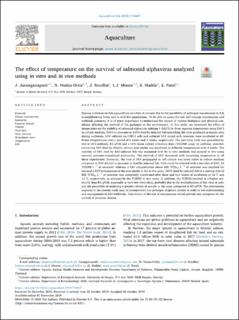| dc.description.abstract | Disease outbreaks in fish aquaculture are often of concern due to the possibility of pathogen transmission to fish in neighbouring farms and to wild fish populations. To be able to assess the risk and manage transmission and outbreak scenarios, it is of great importance to understand the impact of various biological and physical conditions affecting the survival of the pathogen in the environment. In this study, we examined the effect of temperature on the viability of salmonid alphavirus subtype 3 (SAV3) in three separate experiments using SAV3 in culture medium, SAV3 in seawater or SAV3 shed by infected fish mimicking the virus produced at marine sites during outbreaks. SAV cultured on CHH-1 cells and cultured SAV mixed with seawater were incubated at different temperatures over a period of 4 weeks and 2 weeks, respectively. The surviving virus was quantified by two in vitro methods, RT-qPCR and a 50% tissue culture infectious dose (TCID50) assay. In addition, seawater containing SAV shed by Atlantic salmon post-smolts was incubated at different temperatures over 4 weeks. The viability of SAV shed by SAV-infected fish was examined both by in vitro methods and assayed in vivo using recently seawater-transferred post-smolts. The survival of SAV decreased with increasing temperature in all three experiments. Generally, the titre of SAV propagated in cell culture was more stable in culture medium compared to SAV diluted in seawater or shed by infected fish. Cells could be infected with a low titre of SAV, 24 TCID50 L−1 of seawater, whereas a SAV concentration above 448 TCID50 L−1 of seawater was required for successful SAV transmission to the post-smolts in the in vivo assay. SAV3 shed by infected fish at a starting titre of 882 TCID50 L−1 of seawater was completely inactivated after three and four weeks of incubation at 16 °C and 12 °C, respectively, as analysed by the TCID50 in vitro assay. In addition, the TCID50 resulted in a higher sensitivity than RT-qPCR, especially at very low virus titres, probably due to the multiplication of the virus in cells and the possibility of analysing a greater volume of sample in the assay compared to RT-qPCR. The information acquired in the present study may be incorporated into pathogen dispersal models in order to aid understanding and management of SAV outbreaks. Calculation of the risk of transmission would provide new prospects for the control of pancreas disease. | en_US |
